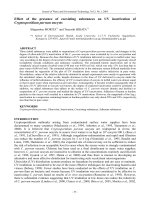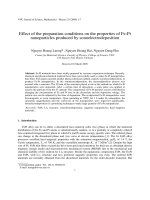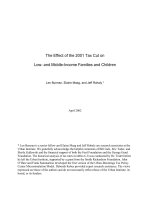Effect of potassium hydroxide (KOH) pretreatment on solids recovery, delignification and total sugars of cotton stalk
Bạn đang xem bản rút gọn của tài liệu. Xem và tải ngay bản đầy đủ của tài liệu tại đây (380.81 KB, 11 trang )
Int.J.Curr.Microbiol.App.Sci (2019) 8(2): 2457-2467
International Journal of Current Microbiology and Applied Sciences
ISSN: 2319-7706 Volume 8 Number 02 (2019)
Journal homepage:
Original Research Article
/>
Effect of Potassium Hydroxide (KOH) Pretreatment on Solids Recovery,
Delignification and Total Sugars of Cotton Stalk
Premkumari1*, M. Veerangouda1, Vijayakumar Palled1, M. Anantachar1,
Sharanagouda Hiregoudar2, Nagaraj M. Naik3 and R.V. Beladadhi4
1
Department of Farm Machinery and Power Engineering, 2Department of Processing and
Food Engineering, University of Agricultural Sciences, Raichur 584104, Karnataka, India
3
Pesticide Residue and Food Quality Analysis Laboratory, University of Agricultural
Sciences, Raichur 584104, Karnataka, India
4
Department of Soil Science and Agricultural Chemistry, University of Agricultural Sciences,
Raichur 584104, Karnataka, India
*Corresponding author
ABSTRACT
Keywords
Cotton stalk,
Cellulose, Ethanol,
Potassium
hydroxide, Pretreatment
Article Info
Accepted:
18 January 2019
Available Online:
10 February 2019
Bioethanol is one of the promising alternative fuels to gasoline in the transport sector.
Ethanol may be produced either from petroleum products or from biomass. In the world
around 80% of the ethanol produced is still obtained from fermentation and the reminder
comes largely by synthesis from the petroleum product ethylene (Tanaka, 2006). Cotton
stalks have been regarded as potential sources for cellulosic ethanol production owing to
their high cellulose content being almost 37% (Binod et al., 2012). Hence, there is a need
of utilizing available biomass resources for production of ethanol to reach energy demand.
Compounding the challenges is the fact that the country lacks mature technologies for
ethanol production from lignocellulosic biomass which is by far the most abundant
renewable resource that may be exploited (Lynd et al., 2002; Zhang, 2008). The goal of
the pretreatment process is to remove lignin and hemicellulose, reduce the crystallinity of
cellulose, and increase the porosity of the lignocellulosic materials. This study is aimed at
investigating the effect of potassium hydroxide (KOH) on cotton stalks for optimization of
pre-treatment conditions on solids recovery, delignification and total sugars. Potassium
hydroxide (KOH) pre-treatment was performed at 50 °C, 70 °C with residence times of 6,
12, and 24 h and 120 °C with residence times of 0.25, 0.5 and 1 h each. All the
temperature–time pretreatment combinations were performed with potassium hydroxide
(KOH) concentrations of 1, 2 and 3%. Solid recoveries, AIL, ASL, total sugars, cellulose
and hemicelluloses content after each pretreatment ranged between 49.60-85.04%, 10.1923.96%, 1.51-1.95%, 268.01-419.51(mg/g dry biomass), 33.00-53.54% and 1.17-14.04%
respectively. Maximum lignin reductions at different temperatures were all obtained at the
combinations of highest KOH concentrations and longest treatment times, which indicated
a close relationship between pretreatment severity and lignin reduction.
2457
Int.J.Curr.Microbiol.App.Sci (2019) 8(2): 2457-2467
Introduction
Currently the world is mostly dependent on
fossil fuels for meeting its energy demand and
more than 80% of the total global energy is
obtained by burning fossil fuels, of which
58% alone is consumed by the transport
sector. Rapid increase in the consumption of
all kinds of fossil fuels due to the growing
industrialization and motorization of the
world has resulted in fast depletion of these
non-renewable fuels. The limited reserves of
the fossil fuels have been anticipated to be
exhausted by the next 40-50 years and fossil
fuels has the contribution to greenhouse gas
emissions and global warming that cause
climate change, rise in sea level and loss of
biodiversity and urban pollution (Anon,
2013). Therefore, it is necessary to find out an
alternative energy source for our industrial
economies and consumer societies by using
renewable, sustainable, efficient and cost
effective feedstocks with lesser emission of
greenhouse gases, where bioethanol would be
an attractive alternative option due to its ease
of production.
Ligno cellulosic biomass refers to plant
biomass that is composed of cellulose,
hemicellulose, and lignin. The carbohydrate
polymers (cellulose and hemicelluloses) are
tightly bound to the lignin. They have been
considered as alternative energy sources
because they can capture CO2 during their
growth so that their combustion does not
generate
net
CO2.
Cellulose
and
hemicellulose are polysaccharides that can be
used for ethanol production, while lignin is a
complex aromatic polymer that stiffens and
surrounds the fibres of polysaccharides.
Cotton is a major commercial crop grown in
almost all the Agro-climatic zones of
Karnataka. All the four cultivated species of
cotton viz., Gossypium arboreum, G.
herbaceum, G. barbadense, and G. hirsutum
are grown in the state where in Gossypium
hirsutum has the major share of the hybrid
cotton grown. Cotton stalk is one of the
important by products of cotton crop and
about 23 million tonnes of cotton plant stalks
are generated in India annually. On an
average about 2 to 3 tonnes of stalk are
generated in one hectare of land. Most of the
stalk is treated as waste, though a small part
of it (15%) is used as fuel. The lignocellulosic
nature of cotton stalk favours to use as
renewable material for variety of commercial
applications. In conventional method, bulk of
the stalk is burnt in the fields after the harvest
of the cotton crop although it is not desirable
since it causes air pollution. Hence, it is
required to utilize cotton stalk for ethanol
production instead of burning in the field.
The conversion of lingo cellulosic biomass to
ethanol is more challenging. The process of
ethanol production from lingocellulosic
biomass constitutes three stages: (a)
pretreatment of biomass to reduce lignin
content and cellulose crystallinity, (b)
hydrolysis of pretreated biomass for sugar
generation, and (c) fermentation of sugars into
ethanol.
Pretreatment of biomass has been found to
change its macromolecular structure and
increase surface area and pore size, making it
conducive for hydrolytic enzymes to attach
themselves to the carbohydrate matrix for
generating sugars, which are subsequently
converted to ethanol through bacterial or
yeast fermentation. Pretreatment can be
divided into three main categories: (a)
physical, (b) chemical, and (c) biological.
Physical pretreatment processes have proven
to be energetically unviable and biological
pretreatment methods can be expensive and
time consuming. Chemical pretreatment
techniques on the other hands have been the
most widely studied and alkaline pretreatment
in particular has seen considerable success
(Vijayakumar et al., 2016).
2458
Int.J.Curr.Microbiol.App.Sci (2019) 8(2): 2457-2467
Silverstein et al., (2007) investigated
chemical pretreatment of cotton stalks and
reported that, among four pretreatment
methods (NaOH, H2SO4, H2O2, and ozone
pretreatments), NaOH pretreatment resulted
in the highest level of delignification (65.63%
at 2% NaOH, 90 min, 121 °C) and cellulose
conversion (60.8%).
Shi et al., (2009) studied the fungus,
Phanerochaete chrysosporium, to pretreat
cotton stalks with two methods, shallow
stationary and agitated cultivation, at three
supplemental
salt
concentrations.
Pretreatment efficiencies were compared by
evaluating lignin degradation, solid recovery
and carbohydrate availability over a 14-day
period. Shallow stationary cultivation with no
salts gave 20.7% lignin degradation along
with 76.3% solid recovery and 29.0%
carbohydrate availability. The highest lignin
degradation of 33.9% at a corresponding solid
recovery and carbohydrate availability of
67.8% and 18.4%, respectively, was obtained
through agitated cultivation with Modified
NREL salts.
Keshav et al., (2016) reported that cotton
stalk pretreated to steam explosion in the
range 170-200 °C for 5 min. Steam explosion
at 200 °C and 5 min led to significant
hemicellulose solubilization (71.90±0.10%).
Alkaline extraction of steam exploded cotton
stalk (SECOH) using 3% NaOH at room
temperature for 6 h led to 85.07±1.43% lignin
removal with complete hemicellulose
solubilization. Besides, this combined
pretreatment allowed a high recovery of the
cellulosic fraction from the biomass.
Enzymatic saccharification was studied
between steam exploded cotton stalk (SECS)
and SECOH using different cellulase
loadings. SECOH gave a maximum of
785.30±8.28 mg/g reducing sugars with
saccharification efficiency of 82.13±0.72%.
Subsequently, fermentation of SECOH
hydrolysate containing sugars (68.20±1.16
g/l) with Saccharomyces cerevisiae produced
23.17±0.84 g/l ethanol with 0.44 g/g yield.
Potassium hydroxide is a relatively less
explored pretreatment agent but could
potentially be used for lignocellulose
pretreatment due to its reported reactivity
with carbon nanofibers and carbon
nanostructures and its ability to deacetylate
biomass.
Keeping this in view, the effect of alkaline
pretreatment conditions on delignification and
total sugar content of cotton stalks was
investigated.
Materials and Methods
Cotton stalk is selected as raw material in this
study for testing its feasibility for production
of cellulosic ethanol. The cotton stalks
available in the University of Agricultural
Sciences, Raichur campus was selected. The
cotton stalks were cut into small chips and
oven dried at 70 °C in a forced air oven for 72
h. Then oven dried samples were ground to
pass through a 2 mm sieve in a hammer mill
and stored at room temperature in zip-locked
plastic bags, and used for further
experimentation.
The initial composition of cotton stalk was
analyzed using Laboratory Analytical
Procedures (LAP) adopted by National
Renewable Energy Laboratory (NREL) for
the measurement of total solids, acid insoluble
lignin (AIL), acid soluble lignin (ASL) and
ash (Sluiter et al., 2005a, 2005b; Sluiter et al.,
2008). While the structural carbohydrates
(cellulose and hemicelluloses) represented by
total reducing sugars of biomass was
estimated by the 3, 5-dinitrosalycylic acid
(DNS) method (Ghose, 1987; Miller, 1959).
Whereas, the crude protein, crude fibre and
crude fat present in cotton stalk were
2459
Int.J.Curr.Microbiol.App.Sci (2019) 8(2): 2457-2467
estimated by the AOAC method (AOAC,
2005). Cellulose was estimated by standard
cellulose solution methods and hemicellulose
was estimated by determining (ADF) acid
detergent fibre and (NDF) neutral detergent
fibre.
treatments in this study were conducted in
triplicate.
In this experiment, potassium hydroxide
(KOH) pretreatment of cotton stalk at
different elevated temperatures ranging from
50 to 120 °C with various combinations of
residence times and KOH concentrations was
explored. Pretreatment of cotton stalk samples
were performed at 50, 70 with residence times
of 6, 12, and 24 h and 120 °C with residence
times of 0.25, 0.5, and 1 h each. All the
temperature–time pretreatment combinations
were performed with potassium hydroxide
(KOH) concentrations of 1, 2 and 3 per cent
(w/v).
The initial composition of cotton stalk used in
this study is presented in Table 1. The
carbohydrate (total reducing sugars) of cotton
stalk was estimated to be 58.66%. Cellulose
and hemicelluloses were 42.63% and 16.03%
respectively. Total lignin (including AIL and
ASL), which is the major non-carbohydrate
component, was determined to be 32.72 %,
ash and total solids were estimated to be
5.56% and 92.08% respectively. The crude
fibre, fat and protein of sample were observed
to be 49.71%, 0.9% and 1.7% respectively.
Results and Discussion
Composition of cotton stalk
Effect of pretreatment conditions
Five grams of cotton stalk sample was mixed
with 50 ml of KOH solution in 125 ml bottles
using glass rods, and the bottles were sealed
before pretreatment and kept in a water bath
(Plate 1) and autoclave (Plate 2).
The pretreated samples were filtered through
pre-weighed filter paper in vacuum flask
using a vacuum pump. The bottles were
rinsed with 50 ml DI water to recover the
residual solids. All solids accumulated on the
filter papers in the filtration set up were
quantified by oven drying and considered in
solid recovery calculations.
5 g of wet biomass was drawn from each
pretreated sample and dried at 105 °C in
conventional hot air oven for estimation of
solid recovery. A similar amount was placed
for vacuum drying at 40 °C in vacuum oven
to obtain samples for estimation of acid
insoluble lignin (AIL), acid soluble lignin
(ASL),
total
sugar,
cellulose
and
hemicellulose content to study the effect of
pretreatment conditions on cotton stalk. All
Pretreatment conditions had varying effects
on solid recovery, acid insoluble lignin and
acid soluble lignin, total sugar, cellulose and
hemicellulose in the biomass. Intensity of
treatment increased with increasing KOH
concentration and treatment temperature.
Solid recovery
On an average, solid recoveries after
pretreatment at different temperature-time
combinations using various concentrations of
KOH ranged between 64.85 and 85.04% at
50°C, 59.13-81.29% at 70°C, and 68.5949.6% at 120°C (Table 2).
It was observed that the maximum solids of
85.04% in the sample pretreated at 50 °C, 6 h
combination with 1% KOH, whereas, it was
minimum 49.60% in the sample pretreated
with 3% KOH at 120 °C, 1 h. It was observed
that lesser solids were recovered as intensity
of the pretreatment increased.
2460
Int.J.Curr.Microbiol.App.Sci (2019) 8(2): 2457-2467
Acid insoluble lignin
Acid insoluble lignin after pretreatment at
different temperature-time combinations
using various concentrations of KOH ranged
between 16.1-23.96% at 50 °C (Fig. 1), 14.120.25% at 70 °C (Fig. 2) and 10.19-16.8% at
120 °C (Fig. 3). The maximum acid insoluble
lignin of 23.96% was recorded in the sample
pretreated at 50 °C, 6 h combination with 1%
KOH, whereas, it was minimum (10.19 %) in
the sample pretreated with 3% KOH at 120
°C, 1 h.
It was observed that increasing pretreatment,
a decrease in acid insoluble lignin in all the
samples with three concentrations of KOH
loaded
at
all
the
temperature-time
combinations were recorded.
The maximum sugars of 419.51 mg/g were
released, when the sample was pretreated with
2% KOH concentration at 120 °C for 1 h.
Whereas, it was minimum (268.01%) in the
sample pretreated at 50 °C, 6 h combination
with 1% KOH.
Cellulose content
The results of cellulose content ranged
between 29.02-48.54% after pretreatment at
different temperature-time combinations
using various concentrations of KOH (Table
4).
The maximum cellulose content of 48.54%
was observed in the sample pretreated at 120
°C, 1 h combination with 2% KOH, whereas,
it was minimum (29.02%) in the sample
pretreated with 1% KOH at 50 °C, 6 h.
Acid soluble lignin
After KOH pretreatment, acid soluble lignin
at different temperature-time combinations
using various concentrations of KOH ranged
between 1.54-1.79% at 50 °C, 1.56-1.83% at
70 °C and 1.56-1.95% at 120 °C.
It was observed that when the sample was
pretreated at 50, 70 and 120 °C with different
concentrations of KOH, the release in
cellulose increased with increase in akali
concentration upto 2% (v/v) KOH and it
declined
thereafter
by
increasing
concentration.
It was observed that acid soluble lignin
increased up to 2% KOH concentration at
higher temperature-time combinations.
Hemicellulose content
Total sugar content
On an average, total sugar content ranged
between 268.01-419.51 mg/g dry biomass
(Table 3) after pretreatment at different
temperature-time combinations using various
concentrations of KOH.
It was observed that when the sample was
pretreated with different concentrations of
KOH, at 50, 70 and 120 °C, the release in
sugar increased with increase in acid
concentration upto 2% (v/v) KOH and it
declined thereafter.
Hemicellulose content ranged between 1.1714.04% after pretreatment at different
temperature-time combinations using various
concentrations of KOH.
After KOH pretreatment, hemicelluloses
content ranged between 8.34-14.04% at 50 °C
(Fig. 4), 4.93-8.96% at 70 °C (Fig. 5), and
1.17-5.19% at 120 °C (Fig. 6).
The maximum hemicellulose content of
14.04% was observed in the sample pretreated
at 50 °C, 6 h combination with 3% KOH,
whereas, it was minimum (1.17%) in the
sample pretreated with 2% KOH at 120 °C, 1
h.
2461
Int.J.Curr.Microbiol.App.Sci (2019) 8(2): 2457-2467
Table.1 Composition of cotton stalk
Sl. No.
1
2
3
4
5
6
7
8
9
10
Component
Total solids
Acid insoluble lignin
Acid soluble lignin
Total sugars
Cellulose
Hemicellulose
Ash
Crude fiber
Crude fat
Crude protein
Dry weight (%)
92.08
30.71
2.01
58.66
42.63
16.03
5.56
49.71
0.9
1.7
Table.2 Effect of potassium hydroxide pretreatment on solids recovery of cotton stalk
Temperature (°C)
Time, h
70
6
12
24
6
12
24
0.25
0.5
1
50
120
1
85.04
80.07
79.14
81.29
78.59
74.89
68.59
63.38
59.01
Solids recovery (%)
KOH concentration (%)
2
82.89
74.97
68.95
74.58
73.4
64.85
63.85
58.53
51.71
3
79.36
72.98
64.85
69.46
66.81
59.13
61.59
54.23
49.6
Table.3 Effect of potassium hydroxide (KOH) pretreatment on total sugars of cotton stalk
Temperature (°C)
50
70
120
Time, h
Total sugars (mg/g dry biomass)
KOH concentration (%)
1
2
3
268.01
303.46
293.10
323.16
354.71
349.64
353.18
365.56
357.20
343.78
356.11
353.60
359.68
367.37
363.46
363.60
373.29
367.38
376.98
393.47
382.63
386.99
403.84
399.69
402.58
419.51
409.79
6
12
24
6
12
24
0.25
0.5
1
2462
Int.J.Curr.Microbiol.App.Sci (2019) 8(2): 2457-2467
Table.4 Effect of potassium hydroxide (KOH) pretreatment on cellulose of cotton stalk
Temperature (°C)
50
70
120
Time, h
1
35.02
37.26
38.60
39.62
42.61
44.85
46.48
48.78
50.42
6
12
24
6
12
24
0.25
0.5
1
Cellulose (%)
KOH concentration (%)
2
36.91
39.77
40.34
41.51
45.98
47.84
49.96
51.93
53.54
3
33.00
35.12
36.35
37.61
41.67
42.52
45.44
47.51
49.67
Fig.1 Acid insoluble lignin of cotton stalk pretreated with 1.0–3.0% KOH at 50 °C
Fig.2 Acid insoluble lignin of cotton stalk pretreated with 1.0–3.0% KOH at 70 °C
2463
Int.J.Curr.Microbiol.App.Sci (2019) 8(2): 2457-2467
Fig.3 Acid insoluble lignin of cotton stalk pretreated with 1.0–3.0% KOH at 120 °C
Fig.4 Hemicellulose content of cotton stalk pretreated with 1.0–3.0% KOH at 50 °C
Fig.5 Hemicellulose content of cotton stalk pretreated with 1.0–3.0% KOH at 70 °C
2464
Int.J.Curr.Microbiol.App.Sci (2019) 8(2): 2457-2467
Fig.6 Hemicellulose content of cotton stalk pretreated with 1.0–3.0% KOH at 120 °C
Plate.1 Samples kept in water bath for pretreatment
Plate.2 Pretreatment using fully automatic horizontal autoclave
2465
Int.J.Curr.Microbiol.App.Sci (2019) 8(2): 2457-2467
In conclusion, pretreatment of ground cotton
stalk with KOH resulted in high sugar yield
with the 2% KOH, 1 h, 120 °C pretreatment
indicates that even low concentrations of
KOH can be effective in generating high
sugars during hydrolysis. The highest
carbohydrate retention of 71.51% was
observed in the sample pretreated at 120 °C
with 2% KOH and 1 h. Almost 53.95% of
solids were dissolved at 120 °C after 1 h
pretreatment with 3% KOH concentration.
The
corresponding
maximum
lignin
reductions of 50.79%, 56.91% for 50, 70 °C
at 24 h, 3% KOH respectively and 68.86%
were obtained at 120 °C for 1 h, 3% KOH
concentrations. Pretreatment with potassium
hydroxide was able to degrade lignin in cotton
stalks. Maximum lignin reductions at
different temperatures were all obtained at the
combinations of highest KOH concentrations
and longest treatment times, which indicated a
close relationship between pretreatment
severity and lignin reduction.
References
Alvira, P., Tomas-Pejo, E., Ballesteros, M.
and Negro. M. J., 2010, Pretreatment
technologies
for
an
efficient
bioethanol production based on
enzymatic hydrolysis: A review.
Bioresour. Technol., 101(13): 48514861.
Amrita, V., Santosh, K. and Jain, P. K., 2011,
Key pretreatment technologies on
cellulosic ethanol production. J.
Scientific Res., 55(2): 57-63.
Anonymous, 2003, Report of the committee
on development of biofuels. Planning
Commission, Government of India.
< />orts/ genrep / cmtt _ bio. pdf >
AOAC, 2005, Official methods of analysis,
(16th Edi), Association of official
analytical chemists, Gaithersburg,
MD, USA.
Binod, P., Kuttiraja, M., Archana, M., Janu,
K. U., Sindhu, R., Sukumaran, R. K.
and Pandey, A., 2012, High
temperature
pretreatment
and
hydrolysis of cotton stalk for
producing sugars for bioethanol
production. Fuel, 92(1): 340-345.
Du, S. K., Zhu, X., Wang, H., Zhou, D.,
Yang, W. and Xu, H., 2013, High
pressure assist-alkali pretreatment of
cotton stalk and physiochemical
characterization
of
biomass,
Bioresour. Technol., 148(3): 494-500.
Ghose, T. K., 1987, Measurement of cellulase
activities. Pure and Appl. Chem.,
59(2): 257-268.
Gurjar, R, M., Shaikh, A, J., Balasubramanya,
R, H. and Sreenivasan, S., 2007,
Composite boards from cotton stalks.
Central Institute for Research on
Cotton
Technology,
Matunga,
Mumbai-400 019.
Jiang, W., Chang, S., Hongqiang, L.,
Oleskowicz-Popiel, P. and Xu, J.,
2015, Liquid hot water pretreatment
on different parts of cotton stalk to
facilitate
ethanol
production.
Bioresour. Technol., 176(1): 175-180.
Kaura, U., Oberoia, H, S., Bhargavb, V.,
Sharma, R, S. and Dhaliwala, S, S.,
2012, Ethanol production from
alkaliand ozonetreated cotton stalks
using
thermotolerant
Pichia
kudriavzevii HOP1. Ind. Crops and
Products. 37(1): 219-226.
Keshav, P. K., Naseeruddin, S. L. and Rao,
V., 2016, Improved enzymatic
saccharification of steam exploded
cotton stalk using alkaline extraction
and fermentation of cellulosic sugars
into ethanol. Bioresour. Technol.,
214(8): 363-370.
Lynd, L. R., Weimer, P. J., Van Z. W. H. and
Pretorius, I. S., 2002, Microbial
cellulose utilization: fundamentals and
biotechnology. Micro. Mol. Biol. Rev.
2466
Int.J.Curr.Microbiol.App.Sci (2019) 8(2): 2457-2467
66(3): 506-577.
Miller, G. L., 1959, Use of dinitrosalicylic
acid reagent for determination of
reducing sugars. Anal. Chem., 31(3):
426-428.
Placido, J., Imam, T. and Capareda, S., 2013,
Evaluation of ligninolytic enzymes,
ultrasonication and liquid hot water as
pretreatments
for
bioethanol
production from cotton gin trash.
Bioresour. Technol., 139(7): 203-208.
Shi, J., Mari, S. and. Sharma, R, S., 2008,
Microbial pretreatment of cotton
stalks by solid state cultivation of
Phanerochaete
chrysosporium.
Bioresour. Technol., 99(14): 65566564.
Shi, J., Sharma, R. S. and Mari S, C., 2009,
Microbial pretreatment of cotton
stalks by submerged cultivation of
Phanerochaete
chrysosporium.
Bioresour. Technol., 100(19): 43884395.
Silverstein, R. A., Chen, Y., SharmaShivappa, R. R., Boyette, M. D. and
Osborne, J., 2007, A comparison of
chemical pretreatment methods for
improving saccharification of cotton
stalks. Bioresour. Technol., 98(16):
3000-3011.
Singh, A., Bajara, S. and Bishnoi, N, R.,
2017, Physico-chemical pretreatment
and enzymatic hydrolysis of cotton
stalk for ethanol production by
Saccharomyces cerevisiae. Bioresour.
Technol., 244(1): 71-77.
Sluiter, A., Hames, B., Hyman, D., Payne, C.,
Ruiz, R., Scarlata, C., Sluiter, J.,
Templeton, D. and Wolfe, J., 2005a,
Determination of total solids in
biomass and total dissolved solids in
liquid process samples. Laboratory
Analytical Procedure (LAP). Golden:
National
Renewable
Energy
Laboratory.
Sluiter, A., Hames, B., Ruiz, R., Scarlata, C.,
Sluiter, J. and Templeton, D., 2005b,
Determination of ash in biomass.
Laboratory Analytical Procedure
(LAP). Golden: National Renewable
Energy Laboratory.
Sluiter, A., Hames, B., Ruiz, R., Scarlata, C.,
Sluiter, J., Templeton, D. and Crocker,
D., 2008, Determination of structural
carbohydrates and lignin in biomass.
Laboratory Analytical Procedure
(LAP). Golden: National Renewable
Energy Laboratory.
Soni, B. and Hass ana, B., 2015, Chemical
isolation and characterization of
different cellulose nano fibers from
cotton stalks. Carbohydr. Polym.,
134(12): 581-589.
Tanaka, Y. L., 2006, Ethanol fermentation
from biomass resources: current state
and
prospects.
Appl.
Micro.
Biotechnol., 69(6): 627-642.
Vijayakumar,
P.,
Anantachar,
M.,
Veerangouda, M., Prakash, K. V.,
Ramachandra, C. T., Nagaraj, M. N.,
Beladadhi, R. V., Manjunatha, K. and
Ramesh, B., 2016, Effect of alkaline
pre treatment on solids recovery and
delignification of Prosopis juliflora.
Eco. Env. Cons. 22: S59-S64.
Zhang, Y. H., 2008, Reviving the
carbohydrate economy via multiproduct lignocelluloses biorefineries.
J. Ind. Microbiol. Biotechnol., 35(5):
367-375.
How to cite this article:
Premkumari, M. Veerangouda, Vijayakumar Palled, M. Anantachar, Sharanagouda Hiregoudar,
Nagaraj M. Naik and Beladadhi, R.V. 2019. Effect of Potassium Hydroxide (KOH)
Pretreatment on Solids Recovery, Delignification and Total Sugars of Cotton Stalk.
Int.J.Curr.Microbiol.App.Sci. 8(02): 2457-2467. doi: />2467









